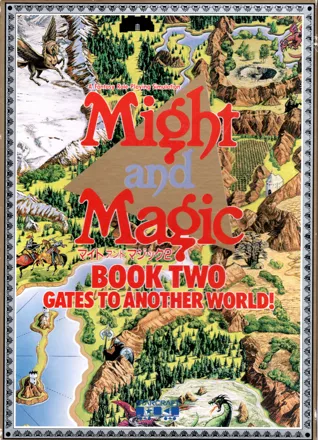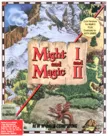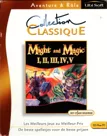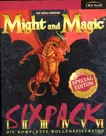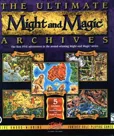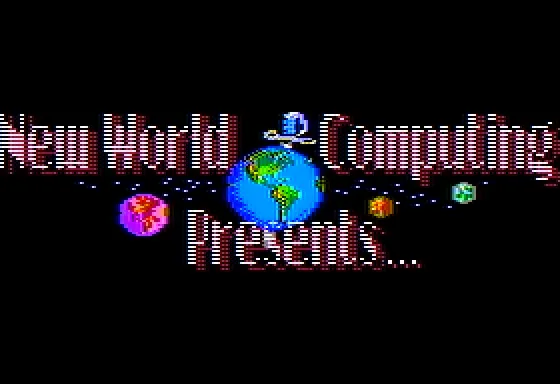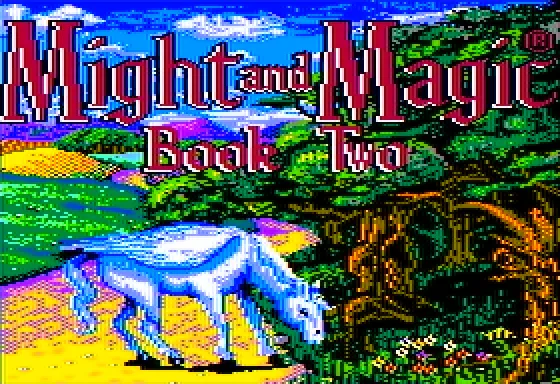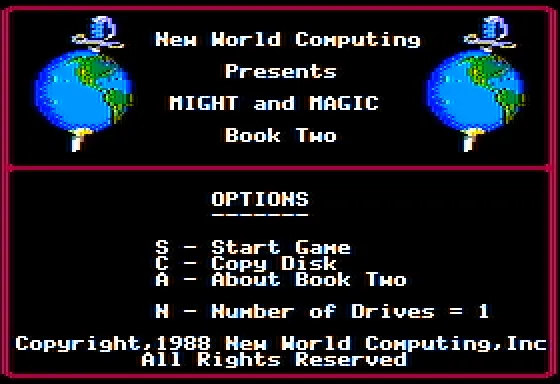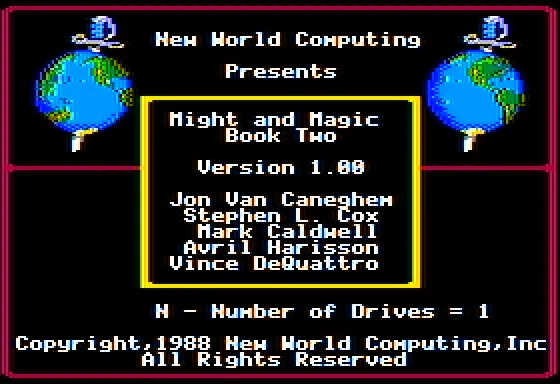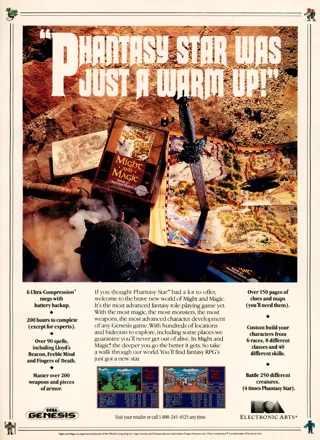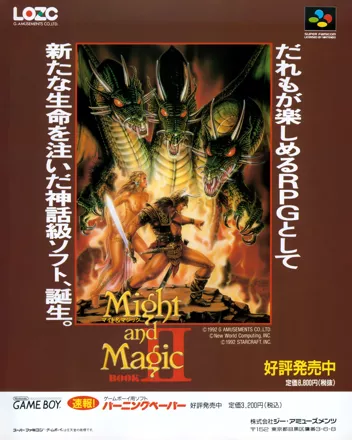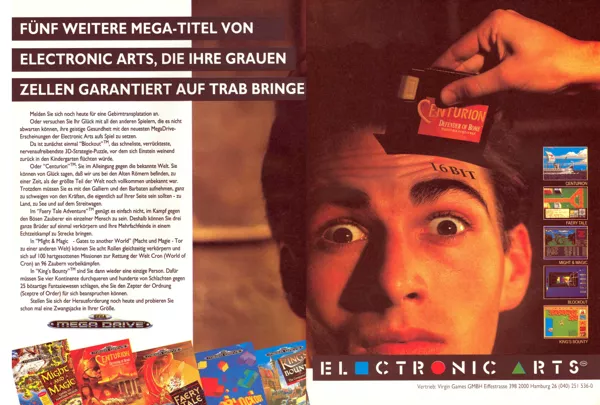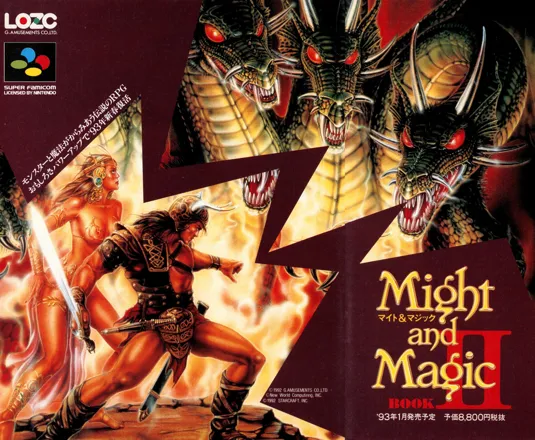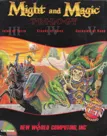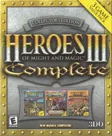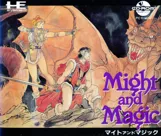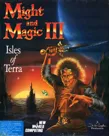Might and Magic II: Gates to Another World
Description official descriptions
The space traveler and rogue guardian Sheltem has left the world VARN, where he was pursued by the relentless Corak the Mysterious and a party of local adventurers helping him. The Gates to Another World eventually takes all of them to another world, known as CRON. There, a great turmoil is caused by Sheltem's actions, and the heroes must stop his madness, preventing him from casting the planet into its own sun.
Gates to Another World is the second installment in the Might and Magic series, and a sequel to Secret of the Inner Sanctum. Core gameplay is similar to predecessor, with the player creating a party of six characters and exploring vast first-person 3D environments, while fighting enemies in turn-based combat and leveling up. Unlike the first game, enemy encounters occur at set points rather than spawning randomly, though enemy type selection is still random.
Like in the previous game, character classes rely each on a particular attribute to be effective. Knight, Paladin, Archer, Cleric, Sorcerer and Robber return, with the addition of two new classes, Ninja and Barbarian. Race selection features humans, elves, dwarves, gnomes, and half-orcs. There are several locations and items that are restricted to certain genders, alignments, or races. A new feature is the possibility to hire two non-player characters to travel with the party and participate in battles. A new skill system is introduced as well, allowing characters to learn such abilities as mountaineering (necessary to traverse mountains), linguist (for reading certain messages), cartographer (for creating an auto-map), and others.
Compared to the first game, the sequel is more quest-oriented, with various characters in towns giving quests to the party, as opposed to purely exploration-based traveling in the predecessor. Time also plays a large role in this game, with some instances requiring the party to travel to different time periods. Characters also age as the game goes on; If the player waits too long, the characters' statistics will change to reflect their aging, and they will eventually die.
Spellings
- 魔法門 II - Traditional Chinese spelling
Groups +
- Console Generation Exclusives: Sega Genesis
- Fantasy creatures: Dragons
- Fantasy creatures: Dwarves
- Fantasy creatures: Elves
- Fantasy creatures: Gnomes
- Fantasy creatures: Goblins
- Fantasy creatures: Griffins
- Fantasy creatures: Minotaurs
- Fantasy creatures: Orcs
- Fantasy creatures: Trolls
- Gameplay feature: Importable characters
- Might and Magic series
- Might and Magic universe
- Protagonist: Female (option)
Screenshots
Promos
Credits (DOS version)
17 People · View all
| Designed by | |
| Created by | |
| Original Apple II Version | |
| IBM Version | |
| Computer Graphics by | |
| Music | |
| Sound | |
| Manual Illustrations | |
| Map Illustration | |
| Art Coordinator | |
| Manual | |
| Adventurer's Guide written by |
|
| Corak's Travelogue written by | |
| [ full credits ] | |
Reviews
Critics
Average score: 73% (based on 33 ratings)
Players
Average score: 3.7 out of 5 (based on 80 ratings with 5 reviews)
The Good
I haven't played the seminal first game of the legendary series, mostly because I was told that this second installment is like a more polished, upgraded version of it. Also, I have to admit that I can't stand the lack of an automap feature in old first-person games with complex dungeons, and Might and Magic II is famous, among other things, for being one of the first games with an automap feature.
Might and Magic II is a challenging old-school role-playing game that requires a lot of time, patience, concentration, and conscious effort on the player's part. You begin the game in a fairly maze-like city, controlling a (in-game generated or self-created) party of six weaklings that don't stand a chance even against some of the enemies wandering the town itself. It is your job to train, outfit, and customize this party in such a way that it will be able to defeat fearsome creatures and advance towards the game's final dungeon.
The beauty of the game is that you are completely free to ignore that goal and do whatever you want. You cannot get stuck working on one task, because there are myriads of things to do at any given moment. Unlike Wizardry games, which consisted of one huge dungeon each, and Bard's Tale games, which didn't really have cohesive wilderness, Might and Magic II boasts a vast interconnected world which you can explore at your own pace. And it provides you with the tools to do so in a smooth, elegant fashion - making finding and acquiring those tools a pleasant, rewarding, and fascinating experience. Curious about that seemingly sweet spot between two mountains? Teach one of your characters the Mountaineering skill and climb up there. Can't pass those nasty magical traps in a dungeon on your way towards some coveted gems? Have your Sorcerer learn the Levitate spell, and float right over them. Desperate after losing the same fixed battle with a powerful enemy blocking the road to an important item? Buy a Teleport Orb and materialize right behind him, or find a fountain that raises your attributes for just one fight, or try your luck hiding.
The game is full of such things, and it keeps you busy - not just with fighting and leveling up, but with actual planning and taking care of your character. You'll have to study the game world, get used to it, and figure out where to go, which quest to tackle, which item to hunt for, how to improve your characters. It doesn't hold your hand and expects you, the player, to make your own choices and decisions. Depending on your knowledge of the game, it can appear frustratingly difficult or pleasantly fulfilling - and chances are that you'll experience both those sensations.
There is a huge amount of monsters to fight in the game, yet it nearly does away with what was, in my opinion, a real mood-killer in early RPGs - random enemy encounters. If you set your party attitude to the most discreet, you'll barely encounter random enemies. The foes that do pop up seemingly out of nowhere are actually confined to fixed squares - which means that most of them can be avoided by jumping, teleporting, etherealizing, etc., if you are well familiar with the location's layout and are planning a safe trip. This increases the flexibility of the game, emphasizing knowledge and tactics over brute force and mindless key-mashing. The cool part is that you can also do the complete opposite and actually seek out enemies. The game thus becomes as combat-heavy or as combat-light as you want it to be - but the latter requires you to know it really well and to work hard for it.
One thing I love about Might and Magic II is how unforgiving it seems in the beginning, and how much more benevolent it becomes if you take your time and study it and subsequently outsmart it, instead of getting angry and trying to take it by force. The game walks the tightrope between frustration and reward, and does so masterfully. It is full of tricks you need to discover in order to take advantage of it. There are easy, yet well-hidden sub-quests that net you large chunks of experience or money, hard-to-discover areas providing huge boosts to the party, and enemies way above your level that can nevertheless be vanquished if you know what to do. The fight against the Cuisinarts, which could instantly propel a weak party ten or more levels up, is one of the better-known such occasions. I have to confess that, due to serious time constraints, I've used a guide extensively to get my bearings in the game and finish it quicker than it intended me to, but I almost regret it now and wish I had spent more time with it.
The game has a memorable structure with a distinctly non-obvious, but nevertheless clearly outlined main quest, which includes such interesting episodes as re-writing history by traveling through time, and having characters of each class compete in unique challenges without the help of the rest of the party. Most locations in the game are not required to visit in order to complete the main quest, and you are free to decide whether you want to pursue it strictly or take your time to explore the game's many dungeons and amass experience points, gold, and powerful equipment.
Might and Magic II has an attractive personality. There is something energetic and even flamboyant in its mixture of generic medieval fantasy, time travel, and science fiction. There are jesters telling you silly jokes in castles, hirelings with ridiculous names, and characters using catchphrases taken from Star Trek. And who can forget a giant singing karaoke into his mic-shaped club, listening to which raises your Endurance?
The Bad
If you've heard about the battles against up to 250 opponents, then I don't need to tell you that it is insane. If you haven't, then it is my duty to warn you: there are battles against up to 250 opponents in this game. And yes, it is insane. Holding down Ctrl + A wipes out the enemies much quicker than you'd think, but the catch is that you do need to have a party that is strong enough to wipe them out with default attacks. This is an unnecessary and frustrating feature. Luckily, most such battles can be avoided.
Might and Magic II is very hard if you don't know what you're doing - and you won't, unless you explore the game painstakingly and study it, or use a walkthrough. It is possible to build a powerful party and adventure to your heart's content, but beware: particularly the beginning is highly challenging and frustrating, unless you figure out a couple of tricks to get early gold and experience. Also, even with the maps, the dungeons are very tricky to explore, and most of the truly important locations with the best items are well-hidden.
The text-only interface is tiresome. You'll be micromanaging your party a lot, and it will always take time to execute simple commands. For example, in order to transfer an item from one character to another, you need to press four keys: T, 4 for "item", the number of the desired character, and the letter under which the item appears in your inventory. Casting spells requires a similar procedure.
The Bottom Line
Despite the understandable frustrations associated with older games, it cannot be denied that Might and Magic II is a genuine role-playing giant. Its huge world, chock-full of secrets and things to discover in any order you like, is the game's main star, alongside its addictive, effective, and extensive character-building. So C32 to D1, C55 7 squares to the west, and have fun C93-ing 77 air elementals to get that Photon Blade +23!
DOS · by Unicorn Lynx (181746) · 2018
The Good
It has some of the cool "Might And Magic" atmosphere.
The Bad
The game mostly consists of lots and lots of combat and running around trying to find items needed for quests.
The last few quests are extremely tedious and time-consuming, and require the player to fight extremely hard monsters. But just wait until the final dungeon: it's monotonous beyond belief. Really. I couldn't complete it without cheating and editing the stats of my characters. 'I don't see how anyone can finish it without extra help.
And the ending was the worst of all. After spending 2-3 hours fighting an endless stream of monsters in the final dungeon, the reward left me feeling like I wasted my time playing the game.
I heard Might And Magic III has a better finale, and I want to see it, but right now I'm turned off by Might And Magic.
The Bottom Line
Only play it if you want to finish all the Might And Magic games.
DOS · by Edward Alie (2) · 2006
The Good
...then you'll love this.
After Book One, you entered the Gates to Another World. It was not long until you arrived at the other side. Remember in the good old days when getting the sequel to your favorite RPG was only a year away because they used the same game engine to continue the series? Well that's what they did here. Its the same game with a few touch ups.
Now you can have special skills and they added a couple of new classes. The spell list has been revised and expanded. You can now add two NPC characters to your party. Graphics are updated and best of all this game now has an automap.
Hardcore RPGers will appreciate the fact that the automap is an option, it is actually a skill which you can choose to learn or not. So its up to you if you want build mountains of graph paper or not. I happen to like it because like the first game this one is HUGE! Dozens of outdoor and indoor locations. The original let you visit the astral plane. Part II has four elemental planes to explore. With a non-linear plot, many quests to complete and dozens of places to explore you will definatly get your money's worth.
The Bad
While it was nice not having to wait years for a sequel, using the old engine means the same problems are here. The big one being only able to save in the town inns. Resetting of the dungeons is annoying. The real time ending of the game is unexpected. You have been warned.
Graphics are improved but at times it looks like they are trying a bit too hard to be pretty. Because of the limitations of EGA graphics the IBM version uses blue as the skin tone! This is not the case when I played it orginally on the Commodore 64.
The new skills and character classes don't really add much to the game (or detract from it).
The Bottom Line
This was the last game in the series that I would say is truly "old school". VGA graphics and a mouse interface were to follow. This is an excellent RPG that every old schooler should play.
DOS · by woods01 (129) · 2001
Discussion
| Subject | By | Date |
|---|---|---|
| Super Famicom version | Rik Hideto (473408) | Aug 4, 2015 |
| Copying Might and Magic II | mczolton (2) | May 30, 2007 |
Trivia
Cancelled US SNES release
There were plans to release the Super Nintendo version in the US, but it never came to fruition. However, the SNES version was released in other regions.
Hirelings
Hireling ages are calculated in an interesting way. If a hireling is at level one, then they will be 18, but if their level is higher, then one is subtracted from their level number and then added to 18.
References
- The two Wizards the sorceror class has to free in order to complete the plus quest are Yekop and Ybmug--or Pokey and Gumby spelled backwards.
- HK Phooey, a ninja hireling in the game, is named after a cartoon series about a dog who works as a janitor in a police station. The dog moonlights as a ninja by the name of "Hong Kong Phooey".
- Thund R--a barbarian hireling--gets his name from a cartoon called Thundarr the Barbarian.
- There are some woodsmen who challenge you to a tree felling contest. The song they are singing is, "Oh, I'm a lumberjack...". this is in reference to the Monty Python song.
- In Tundara, the portal in the Inn is manned by a guy named Jean-Luc. Star Trek: The Next Generation fans will know him as the captain of the Enterprise from that series. He also offers to "energize" you to your destination, and ends with the captain's line from the series---"Make it so".
- In the Druid's cavern is a location that has cans of spinach. If you eat it, you gain strength. The game also provides a line "You're strong to the finish 'cause you ate your spinach!" that comes from the old AARP cartoon series Popeye the Sailor Man. For those who don't know, Popeye gained strength to defeat his adversaries by eating spinach from a can that he always seemed to either find or have on him.
- In the slums of Sansobar, there is a message on a wall that, when read straight across, begins "Beware of eyes!" It seems to be surrounded by random letters. However, if you read these letters from the top down, you get the following messages: "Hi, Mom" "Spork" "XOXO" and "Slum rat Rule".
- Another hireling is named Jed I. This is, of course, taken from Star Wars' Jedi Knights.
- There is a sorceress by the name of Aeriel who is with Thund R. when you first meet them in Vulcania. As with Thund R., Ariel is the name of a character from Thundarr the Barbarian who was also a sorceress. It's also interesting to note that both these hirelings are human and good, which corresponds to their alter egos in the cartoon series.
- Nakazawa, a ninja hireling, is named after Nakazawa Minoru, president of StarCraft Inc. StarCraft ported MM1 to MM5 (DOS) and King's Bounty to Japanese-made PCs (PC88, PC98, X1, FM-7, MSX2) and published them in Japan.
SNES version
All alcoholic beverages were renamed to non-alcoholic ones (but still give alcohol poisoning), some other places and food were renamed as well and the enemy sprites of the thief (blood on dagger removed) and ghoul (the severed arm used as weapon replaced with a club) were changed.
Awards
- Computer Gaming World
- November 1996 (15th anniversary issue) – #12 Least Rewarding Ending of All Time
Analytics
Upgrade to MobyPro to view research rankings!
Related Sites +
-
Commodore 64 Boxed Sets
For C64: game packaging digitalisations. Include box, manual, brochure, additional material. -
DOSBox Wiki
The encyclopaedic page of the DOSBox project. -
DOSBox, an x86 emulator with DOS
Compatibility statistics page between DOSBox versions and the original game. -
Hall of Light
For Amiga: game database entry; digitalised manuals; game packaging; screenshots; additional material. -
Lemon 64
For Commodore 64: game entry database; advertisement; magazine reviews; music; documentation; cover art; additional material. -
Lemon Amiga
For Amiga: game database entry; magazine reviews; music; manual; additional material. -
MSX Generation
For MSX: game database entry; game packaging; manuals; additional material. -
Macintosh Garden, an abandonware games archive
For Macintosh: reviews; game packaging; downloadable releases; manual; screenshots; additional material. -
Museum of Computer Adventure Game History (C64)
For Commodore 64: game packaging; manuals; media; additional material. -
Museum of Computer Adventure Game History (Electronic Arts, Genesis)
For Sega Genesis: game packaging; manuals; media; additional material. -
Museum of Computer Adventure Game History (Starcraft, SNES)
In Japanese. For Super Famicom: game packaging; manuals; media; additional material. -
Museum of Computer Adventure Game History (Starcraft, Sharp X68000)
In Japanese. For Sharp X68000: game packaging; manuals; media; additional material. -
Shrine at RPGClassics
Fansite with detailed information, maps and a walkthrough (English)
Identifiers +
Contribute
Are you familiar with this game? Help document and preserve this entry in video game history! If your contribution is approved, you will earn points and be credited as a contributor.
Contributors to this Entry
Game added by Old man gamer.
Commodore 64 added by Quapil. Genesis added by PCGamer77. SNES added by Mobygamesisreanimated. Macintosh, Amiga, Apple II, Sharp X68000, FM-7, PC-88, MSX added by Terok Nor. Sharp X1, PC-98 added by Unicorn Lynx.
Additional contributors: MAT, PCGamer77, OceansDaughter, Alaka, Silverblade, formercontrib, Paulus18950, Trypticon, Patrick Bregger, ZeTomes, Motofumi Oka.
Game added June 17, 2000. Last modified July 27, 2024.
